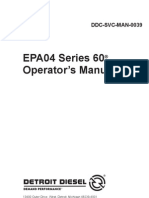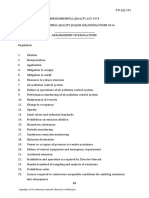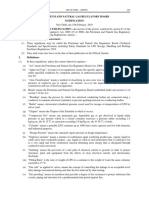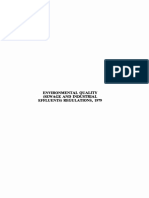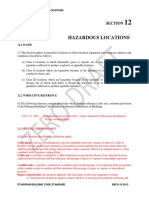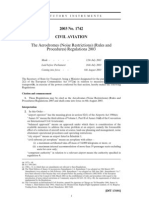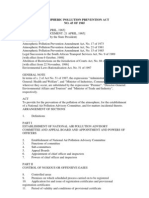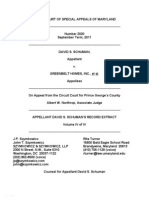Newfoundland and Labrador Regulation 39/04: Air Pollution Control Regulations, 2004 Environmental Protection Act
Newfoundland and Labrador Regulation 39/04: Air Pollution Control Regulations, 2004 Environmental Protection Act
Uploaded by
Brandon CoxCopyright:
Available Formats
Newfoundland and Labrador Regulation 39/04: Air Pollution Control Regulations, 2004 Environmental Protection Act
Newfoundland and Labrador Regulation 39/04: Air Pollution Control Regulations, 2004 Environmental Protection Act
Uploaded by
Brandon CoxOriginal Description:
Original Title
Copyright
Available Formats
Share this document
Did you find this document useful?
Is this content inappropriate?
Copyright:
Available Formats
Newfoundland and Labrador Regulation 39/04: Air Pollution Control Regulations, 2004 Environmental Protection Act
Newfoundland and Labrador Regulation 39/04: Air Pollution Control Regulations, 2004 Environmental Protection Act
Uploaded by
Brandon CoxCopyright:
Available Formats
NEWFOUNDLAND AND LABRADOR
REGULATION 39/04
Air Pollution Control Regulations, 2004
under the
Environmental Protection Act
(O.C. 2004-232)
Amended by:
94/10
34/14
Air Pollution Control Regulations, 2004 39/04
2
Air Pollution Control Regulations, 2004
under the
Environmental Protection Act
(O.C. 2004-232)
(Filed May 20, 2004)
Under the authority of sections 22 and 111 of the Environmental
Protection Act, the Lieutenant-Governor in Council makes the follow-
ing regulations.
Dated at St. Johns, May 19, 2004.
Robert C. Thompson
Clerk of the Executive Council
REGULATIONS
Analysis
1. Short title
2. Definitions
3. Ambient air quality stan-
dards
4. Incineration prohibition
5. Good engineering stack
height
6. Best available control tech-
nology
7. Sulphur dioxide emission
cap
8. Administrative penalty
9. Opacity of visual emissions
10. Performance testing facili-
ties
11. Potential for air pollution in
accident, emergency or ur-
gent circumstances
12. Burning prohibited
13. Burning of waste products
14. Burning of grades 4, 5, or 6
fuel prohibited
15. Residential wood combus-
tion prohibition
16. Motorized vehicles
17. Non-portable aboveground
storage tanks
18. Gasoline distribution net-
works
19. NOx standards for fossil fuel
fired boilers and heaters
20. Monitoring and recording
devices
21. Manner of measurements,
recording and analyses
22. Repeal
Schedule A
Schedule B
Schedule C
Schedule D
Air Pollution Control Regulations, 2004 39/04
3
Schedule E
Schedule F
Schedule G
1. These regulations may be cited as the Air Pollution Control
Regulations, 2004.
39/04 s1
2. In these regulations
(a) "Act" means the Environmental Protection Act;
(b) "air contaminant" means any discharge, release, or other
propagation into the air and includes, but is not limited to,
dust, fumes, mist, smoke, particulate matter, vapours, gases,
odours, odorous substances, acids, soot, grime or any com-
bination of them;
(c) "air pollution" means the presence in air of an air contami-
nant or combination of air contaminants in excess of the
maximum permissible standard, concentration or level as
prescribed by these regulations or an approval issued under
the Act;
(d) "air quality management plan" means a plan developed by
the minister to manage the level of air contaminants in an
area, and may include a company specific air quality man-
agement plan approved by the minister;
(e) "ambient air" means the portion of the atmosphere which is
external to buildings, structures or underground spaces;
(f) "Canadian standard" means the Canadian Standards Associa-
tion Code CAN/CSA-B415.1, Performance Testing of Solid
Fuel Burning Heating Appliances;
(g) "combustion process equipment" means a furnace, boiler,
dryer, apparatus, stack and all appurtenances used in the
combustion process but does not include mobile internal
combustion engines when used to provide propulsion;
Short title
Definitions
Air Pollution Control Regulations, 2004 39/04
4
(h) "department" means the department presided over by the
minister;
(i) "emission" means an air contaminant emitted into the envi-
ronment;
(j) "emission source" means any combustion process equip-
ment, installation, machinery, appliance, equipment or tanks
from which air contaminants may be released or discharged;
(k) "facility" means any stationary property, real or personal,
taken as a whole, which has an emission source;
(l) "fuel" means any fuel used directly or indirectly for heating,
steam generation or electricity production, or for combustion
in industrial processes;
(m) "good engineering stack height (Hg)" means the greater of:
(i) 45 metres,
(ii) the height as calculated using the formula Hg = H +
1.5L where H is the height of any nearby structure and
L is the lesser of the height H or projected width of any
nearby structure, as measured from the ground level
elevation at the base of the stack, or
(iii) the height demonstrated by a fluid model or approved
field study which ensures that stack emissions do not re-
sult in air pollution resulting from atmospheric down-
wash or wakes created by the facility, nearby emission
sources or terrain features;
(n) "heavy duty motorized vehicle" means a vehicle with a gross
vehicle weight rating greater than 2721.6 kilograms for the
1987 model year and older, and greater than 3855.5 kilo-
grams for the 1988 model year and newer;
(o) "light duty motorized vehicle" means a vehicle with a gross
vehicle weight rating less than or equal to 2721.6 kilograms
for the 1987 model year and older, and less than or equal to
3855.5 kilograms for the 1988 model year and newer;
Air Pollution Control Regulations, 2004 39/04
5
(p) "minister" means the minister appointed under the Executive
Council Act to administer the Act;
(q) "modified" means any addition or alteration to emission
sources which may cause:
(i) an increase in the release of an air contaminant, or
(ii) an emission of an air contaminant that was not previ-
ously emitted;
(r) "nearby" means within the lesser of 800 metres or 5 times
the lesser of the height or the projected width of a structure;
(s) "opacity" means the degree to which an emission reduces the
passage of light or obscures the view of an object in the
background, expressed numerically from 0%, transparent, to
100%, opaque;
(t) "particulate matter" means a material, except water in an
uncombined form, that is or has been airborne and exists as a
liquid or a solid at reference conditions;
(u) "point of impingement" includes a part or combination of
those things referred to in subparagraphs (i) to (iii) upon
which an air contaminant may impinge
(i) land and water,
(ii) plant and animal life, including human life, and
(iii) a building, structure, machine or other device or
thing made by humans;
(v) "projected width" means the greatest distance between two
points on a structure;
(w) "reference conditions" means a dry gas temperature of 25
Celsius and a gas pressure of 101.325 kilopascals;
(x) "stack" means a chimney, flue, conduit or duct arranged to
conduct an air contaminant into the environment;
Air Pollution Control Regulations, 2004 39/04
6
(y) "sulphur content" means the amount of sulphur by weight as
determined by standard methods;
(z) "used oil" means a used lubricating oil or waste oil;
(aa) "US EPA standard" means the Standards of Performance for
New Residential Wood Heaters, Title 40, Part 60, Subpart
AAA of the Code of Federal Regulations, published by the
United States Environmental Protection Agency; and
(bb) "visible emission" means an emission which can be detected
by the naked eye.
39/04 s2
3. (1) The ambient air quality standards prescribed in Schedule A
shall be used to maintain air quality in the province.
(2) The concentration of air contaminants due to all sources
shall not exceed the standards prescribed in Schedule A.
(3) For the purpose of ensuring that the standards prescribed in
Schedule A are met, the minister may:
(a) specify a condition in an approval issued under Part XI of
the Act; or
(b) develop an air quality management plan specifying the pro-
visions to reduce the level of air contaminants emitted by
each facility identified in the plan, and the owner or operator
of each facility shall
(i) provide the minister with any information he or she may
require regarding the development of an air quality
management plan, including a company specific air
quality management plan, and
(ii) comply with the provisions of the plan within the time
specified by the minister.
39/04 s3
Ambient air quality
standards
Air Pollution Control Regulations, 2004 39/04
7
4. An owner or operator shall not operate or permit the operation
of new incineration or pyrometric equipment having an in-stack con-
centration in excess of the standards prescribed in Schedule B.
39/04 s4
5. (1) Commencing July 1, 2004, all new stack installations with
annual releases in excess of 20 tonnes of particulate matter or sulphur
dioxide shall meet good engineering stack height.
(2) Subject to subsection (1), for the purposes of enforcing these
regulations, the calculated concentration of an air contaminant at a
point of impingement shall be from good engineering stack height.
39/04 s5
6. (1) An owner or operator who installs a new or modified emis-
sion source shall employ the best available control technology.
(2) Notwithstanding subsection (1), an owner or operator may
install a new or modified emission source which does not comply with
that subsection with the written approval of the minister.
(3) Notwithstanding subsection (1), best available control tech-
nology shall not apply to:
(a) routine maintenance, repair and parts replacement;
(b) normal increases in production rates unless otherwise pro-
hibited;
(c) increases in hours of operation unless otherwise prohibited;
or
(d) use of an alternative cleaner fuel or raw material.
(4) Best available control technology shall be acceptable to the
department and shall, in that particular circumstance, be:
(a) the most effective emission control device or technique;
(b) the most stringent emission control device or technique;
Incineration prohi-
bition
Good engineering
stack height
Best available
control technology
Air Pollution Control Regulations, 2004 39/04
8
(c) proven reliable in comparable processes; and
(d) economically feasible as determined by the minister in light
of industry standards after consultation with the particular
owner or operator.
39/04 s6
7. (1) There is established a provincial sulphur dioxide emission
cap which shall be 60,000 tonnes per calendar year.
(2) Subsection (1) shall come into effect on January 1, 2005.
(3) The owner or operator of a facility which releases in excess
of 20 tonnes of sulphur dioxide per year in the aggregate, shall submit
to the department an annual report on fuel usage, fuel sulphur content,
fuel specific gravity and sulphur dioxide emissions, no later than Feb-
ruary 28 of each subsequent year.
(4) The first report under subsection (3) shall be submitted to
the department no later than February 28, 2006.
39/04 s7
8. (1) For the purpose of environmental protection, the minister
may, under the authority of section 106 of the Act, impose an adminis-
trative penalty prescribed in Schedule C against an owner or operator
who emits an air contaminant.
(2) Administrative penalties imposed under this section shall be
payable within 60 days of notification of the penalty by the department.
39/04 s8
9. (1) The owner or operator of an emission source with a name-
plate capacity greater than 100 GJ / hr, or with an annual particulate
matter release greater than 100 tonnes shall determine the opacity of a
visible emission on a continuous basis.
(2) Notwithstanding subsection (1), the minister may require the
owner or operator of other emission sources to determine the opacity of
a visible emission on a continuous basis.
Sulphur dioxide
emission cap
Administrative
penalty
Opacity of visual
emissions
Air Pollution Control Regulations, 2004 39/04
9
(3) The opacity of a visible emission shall be determined by
means of a continuous opacity monitoring system and shall be calcu-
lated as a 6 minute arithmetic average of instantaneous observations.
(4) An owner or operator shall not cause or permit to be caused
a visible emission having an opacity greater than 20%.
(5) Notwithstanding subsection (4), a visible emission may have
an opacity exceeding 20% but not exceeding 25% for one 6 minute
period in any one hour period.
(6) Notwithstanding subsections (4) and (5), every time a fire is
started in combustion process equipment, a visible emission may have
an opacity exceeding 20%, but not exceeding 40% for one 6 minute
period in the first 30 minute period after that new fire is started.
(7) Commencing July 31, 2005, opacity readings under subsec-
tions (1) and (2) shall be reported monthly to the department by the last
day of each subsequent month.
(8) Where an emission source employs best available control
technology, an owner or operator shall be exempt from the provisions
of subsections (1) to (7).
(9) Where an emission source employs best available control
technology, the owner or operator of that emission source shall
(a) provide the minister with a contingency plan detailing the
remedial action for compliance with the provisions of this
section when best available control technology is non-
operational;
(b) the contingency plan may be approved by the minister, in-
cluding any additions or deletions that the minister may re-
quire; and
(c) the owner or operator shall comply with the approved con-
tingency plan.
(10) Where a continuous opacity monitoring system does not
achieve a monthly valid data capture rate of 95 %, an administrative
penalty of $5 shall be payable with respect to each non-measured opac-
ity reading below the valid data capture rate.
Air Pollution Control Regulations, 2004 39/04
10
(11) Commencing January 1, 2006 an administrative penalty, as
prescribed in Schedule D, shall be payable with respect to opacity
which exceeds the standards in this section.
(12) Administrative penalties imposed under this section shall be
payable within 60 days of notification of the penalty by the department.
39/04 s9
10. (1) The owner or operator of good engineering stack height
installations shall provide the following performance testing facilities:
(a) sampling ports adequate for testing devices and applicable
methods;
(b) safe sampling platforms;
(c) safe access to sampling platforms; and
(d) utilities for sampling and testing devices.
(2) The minister may require the owner or operator of an emis-
sion source other than the emission source referred to in subsection (1)
to provide performance testing facilities.
39/04 s10
11. (1) Where a facility has the potential for air pollution due to an
unanticipated failure to operate in the normal manner due to an acci-
dent, emergency or urgent situation, a change in operating conditions,
or a shut-down of a pollution control device, the owner or operator of
the facility shall:
(a) take immediate remedial action to reduce any emissions and
provide the department with the particulars of that failure,
change or shutdown; and
(b) provide the department in writing with the particulars of the
remedial action taken under paragraph (a) and the reasons
for that action as soon as it is practicable.
(2) Where the minister considers an emission by a facility to be
a nuisance, the owner or operator of that facility shall:
Performance testing
facilities
Potential for air
pollution in acci-
dent, emergency or
urgent circum-
stances
Air Pollution Control Regulations, 2004 39/04
11
(a) investigate to determine the nature of the emission; and
(b) provide the minister with a remediation plan.
(3) The minister may approve the plan required by paragraph
2(b) subject to any changes he or she may require and an owner or
operator shall comply with an approved plan.
(4) Notwithstanding sections 3 and 9, the minister may, under
the authority of section 105 of the Act, enter into a compliance agree-
ment with the owner or operator in writing regarding a situation con-
templated by subsection (1), authorizing the continuance of the opera-
tion for the period of time as the minister considers reasonable.
39/04 s11
12. (1) A person shall not burn or permit the burning of any material
listed in Schedule E in a fire.
(2) Notwithstanding subsection (1), a person may burn or permit
the burning of materials listed in Schedule E in a fire with the written
approval of the minister.
39/04 s12
13. Notwithstanding section 12, a person shall not burn or permit
the burning of used oil, waste products or other materials in combustion
process equipment except
(a) where the design and the intended use of the equipment
according to the manufacturer's manual permits the burning
of the specific material;
(b) where the equipment has the combustion and emission con-
trol devices that may be required by the minister;
(c) where the rate does not exceed the equipment design; and
(d) where the written approval of the minister has been ob-
tained.
39/04 s13
Burning prohibited
Burning of waste
products
Air Pollution Control Regulations, 2004 39/04
12
14. Commencing January 1, 2005, a person shall not burn, or permit
the burning of any fuel, grade numbers 4, 5 or 6
(a) where emission sources employ best available control tech-
nology ,
(i) containing a sulphur content in excess of 3.0%; and
(ii) containing a sulphur content in excess of 2.0% on an
annual basis, as calculated by the formula:
where:
SO
2
= sulphur dioxide
emissions in ton-
nes
V
t
= volume of fuel in
litres; and
(b) where emission sources do not employ best available control
technology,
(i) containing a sulphur content in excess of 2.2%, and
(ii) containing a sulphur content in excess of 2.0% on an
annual basis, as calculated by the formula:
where:
n = number of shipments during a calendar year
S
i
= sulphur content of each shipment, expressed as %
V
i
= volume of each shipment.
Burning of grades 4,
5, or 6 fuel prohib-
ited
( )( )
( )
S V
V
i i
i
n
i
i
n
1
1
( )( )
( . )( )
SO
Vt
2 100000
19579
Air Pollution Control Regulations, 2004 39/04
13
39/04 s14
15. (1) Commencing July 1, 2008 a person shall not manufacture,
sell or permit the selling of a residential woodstove, fireplace insert or
factory built fireplace which may emit particulate matter into the envi-
ronment in excess of:
(a) the emission requirements of the Canadian standard; or
(b) the emission requirements of the US EPA standard.
(2) The emission requirements under subsection (1) shall be
determined by the test methods and procedures contained in that stan-
dard.
(3) Each unit manufactured, permitted or sold under subsection
(1) shall have a readily visible, permanently affixed manufacturers
label which:
(a) conforms to the labelling requirements in that standard; and
(b) indicates that the unit conforms to the particulate matter
emission requirements of that standard.
39/04 s15
16. (1) A person shall not operate or permit the operation of a light
duty motorized vehicle having an emission in excess of the standards
prescribed in Schedule F.
(2) The opacity of a visible emission from a diesel fuelled heavy
duty motorized vehicle, as determined by procedure SAE J1667 enti-
tled Snap Acceleration Smoke Test Procedure for Heavy-Duty Diesel
Vehicles, shall not exceed:
(a) 40% for 1991 model vehicles and newer; and
(b) 55% for 1990 model vehicles and older.
(3) For the purpose of ensuring that the standards prescribed in
Schedule F and subsection (2) are met, according to paragraph
111(1)(p) of the Act, the minister may, by regulation, establish an
Residential wood
combustion prohibi-
tion
Motorized vehicles
Air Pollution Control Regulations, 2004 39/04
14
emission inspection and maintenance program as a means of reducing
exhaust and evaporative air contaminants.
39/04 s16
17. (1) Commencing January 1, 2012, all new and existing non-
portable aboveground storage tanks with a volume greater than 4 m
3
and storing a volatile organic liquid with a vapour pressure greater than
10 kPa at 21.1 Celsius shall comply with the provisions of the CCME
guidelines "Environmental Guidelines for Controlling Emissions of
Volatile Organic Compounds from Aboveground Storage Tanks, PN
1180" including any amendments to those guidelines.
(2) The owner or operator of emission sources shall provide the
department in writing with a plan outlining its schedule for compliance
with subsection (1) no later than January 1, 2006.
(3) All records under Part 7 of the guidelines shall be reported
annually to the department by February 28 of each subsequent year.
(4) The first report under subsection (3) is due no later than
February 28, 2012.
39/04 s17
18. (1) Commencing January 1, 2012, all new and existing persons
engaged in the gasoline distribution network shall comply with the
vapour balancing, recovery and control requirements of the CCME
guidelines "Environmental Code of Practice for Vapour Recovery in
Gasoline Distribution Networks, PN 1057" including any amendments
to those guidelines.
(2) Subsection (1) shall not apply to:
(a) terminals with an annual gasoline throughput less than 25
million litres;
(b) bulk plants with an annual gasoline throughput less than 4.5
million litres;
(c) service stations with an annual gasoline throughput less than
one million litres;
Non-portable
aboveground
storage tanks
Gasoline distribu-
tion networks
Air Pollution Control Regulations, 2004 39/04
15
(d) cargo tank trucks with a capacity less than 21,000 litres; or
(e) ships and barges.
(3) The owner or operator of emission sources shall provide the
department in writing with a compliance schedule no later than January
1, 2006.
(4) All records under Parts 3, 4, 5, & 6 of the guidelines, shall
be reported annually to the department by February 28 of each subse-
quent year.
(5) The first report under subsection (4) is due no later than
February 28, 2012.
39/04 s18; 94/10 s1
19. All new and modified fossil fuel fired boilers and heaters, with a
nameplate capacity equal to or greater than 10.5 GJ/hr, shall not exceed
the emission standards prescribed in Schedule G.
39/04 s19
20. The minister may require the installation of
(a) devices which are necessary to record the throughput and
operation of process, combustion or control equipment; and
(b) monitoring and recording devices which are necessary to
measure and record concentrations of air contaminants,
opacity and flow at their origin and at point of impingement.
39/04 s20
21. All measurements, recordings and analyses conducted under
these regulations shall be
(a) performed at locations and by devices and methods accept-
able to the department; and
(b) made readily accessible to the department in a time and
manner acceptable to the department.
NOx standards for
fossil fuel fired
boilers and heaters
Monitoring and
recording devices
Manner of meas-
urements, recording
and analyses
Air Pollution Control Regulations, 2004 39/04
16
39/04 s21
22. The Air Pollution Control Regulations, 2003, Newfoundland
and Labrador Regulation 56/03, are repealed.
39/04 s22
Repeal
Air Pollution Control Regulations, 2004 39/04
17
Schedule A
Table I: Ambient Air Quality Standards at Reference Conditions
ITEM COLUMN 1 COLUMN 2 COLUMN 3 COLUMN 4 COLUMN 5 COLUMN 6
Name of
Contaminant
Contaminant
Code or CAS
No.
Unit of Concen-
tration
Concentration
Period
of Time
Additional
Notes
1
Ammonia
7664-41-7 Micrograms per
cubic metre of
air
100 24 hour
2
Arsenic
7440-38-2 Total micro-
grams of arsenic
in free and
combined form
per cubic metre
of air
0.3 24 hour
3
Asbestos
1332-21-4 Micrograms per
cubic metre of
air
1.5 24 hour
4
Cadmium
7440-43-9 Total micro-
grams of cad-
mium in free and
combined form
per cubic metre
of air
2 24 hour
5
Carbon
monoxide
630-08-0 Micrograms per
cubic metre of
air
35000
15000
1 hour
8 hour
6
Copper
7440-50-8
Total micro-
grams of copper
in free and
combined form
per cubic metre
of air
50 24 hour
7
Dustfall
Grams of dust-
fall per square
metre
7.0
4.6
30 day
1 year
(1)
(1)
8
Hydrogen
sulphide
7783-06-4 Micrograms per
cubic metre of
air
15
5
1 hour
24 hour
9
Lead
7439-92-1
Total micro-
grams of lead in
free and com-
bined form per
cubic metre of
air
2.0
0.7
24 hour
30 day
(1)
Air Pollution Control Regulations, 2004 39/04
18
ITEM COLUMN 1 COLUMN 2 COLUMN 3 COLUMN 4 COLUMN 5 COLUMN 6
Name of
Contaminant
Contaminant
Code or CAS
No.
Unit of Concen-
tration
Concentration
Period
of Time
Additional
Notes
10
Mercaptans
Total micro-
grams of mer-
captans per cubic
metre expressed
as methyl
mercaptan
20 1 hour
11
Mercury
7439-97-6
Total micro-
grams of mer-
cury in free and
combined form
per cubic metre
of air
2 24 hour
12
Nickel
7440-02-0
Total micro-
grams of nickel
in free and
combined form
per cubic metre
of air
2 24 hour
13
Nitrogen
dioxide
10102-44-0
Total micro-
grams of nitro-
gen oxides per
cubic metre of
air, expressed as
NO
2
400
200
100
1 hour
24 hour
1 year
(1)
14
Ozone
10028-15-6 Micrograms per
cubic metre of
air
160
87
1 hour
8 hour
15
Particulate
matter (less
than 2.5
microns)
Micrograms per
cubic metre of
air
25
8.8
24 hour
1 year
The 3 year
average of the
annual average
concentrations
16
Particulate
matter (less
than 10
microns)
Micrograms per
cubic metre of
air
50 24 hour
17
Particulate
matter (total)
Micrograms per
cubic metre of
air
120
60
24 hour
1 year
(2)
18
Polychlori-
nated biphen-
yls (PCBs)
1336-36-3 Micrograms per
cubic metre of
air
0.15
0.035
24 hour
1 year
(1)
Air Pollution Control Regulations, 2004 39/04
19
ITEM COLUMN 1 COLUMN 2 COLUMN 3 COLUMN 4 COLUMN 5 COLUMN 6
Name of
Contaminant
Contaminant
Code or CAS
No.
Unit of Concen-
tration
Concentration
Period
of Time
Additional
Notes
19
Reduced
sulphur
compounds
Micrograms of
reduced sulphur
compounds per
cubic metre of
air expressed as
hydrogen sul-
phide
30 1 hour
20
Sulphur
dioxide
7446-09-5 Micrograms per
cubic metre of
air
900
600
300
60
1 hour
3 hour
24 hour
1 year
(1)
21
Vanadium
7440-62-2
Total micro-
grams of vana-
dium in free and
combined form
per cubic metre
of air
2 24 hour
22
Zinc
7440-66-6 Micrograms per
cubic metre of
air
120 24 hour
(1) Arithmetic mean
(2) Geometric mean
Table II: Ambient Air Quality Standards for Dioxins and Furans at
Reference Conditions
ITEM COLUMN 1 COLUMN 2 COLUMN 3 COLUMN 4 COLUMN 5 COLUMN 6
Name of
Contaminant
Contaminant
Code or
CAS No.
Unit of Concen-
tration
Concentration
Period
of Time
Additional
Notes
1 Polychlori-
nated di-
benzo-p-
dioxins
(PCDDs) &
poly-
chlorinated
dibenzofurans
(PCDFs)
(TEQ)
Picograms
(TEQ) per cubic
metre of air
5 24 hour (3)
Air Pollution Control Regulations, 2004 39/04
20
(3) The Total Equivalent Quotient (TEQ) concentration of
PCDDs and PCDFs is determined by multiplying the concentration of
each congener listed in Column 1 of Table III by the corresponding
toxicity factor set out in Column 2 of that item and by adding the prod-
ucts of them.
TABLE III: Dioxins and Furans Toxicity Factors
ITEM COLUMN 1 COLUMN 2
Congener Toxicity Factor
1 2,3,7,8-T4CDD 1
2 1,2,3,7,8-P5CDD 0.5
3 1,2,3,4,7,8-H6CDD 0.1
4 1,2,3,6,7,8-H6CDD 0.1
5 1,2,3,7,8,9-H6CDD 0.1
6 1,2,3,4,6,7,8-H7CDD 0.01
7 OCDD 0.001
8 2,3,7,8-T4CDF 0.1
9 1,2,3,7,8-P5CDF 0.05
10 2,3,4,7,8-P5CDF 0.5
11 1,2,3,4,7,8-H6CDF 0.1
12 1,2,3,6,7,8-H6CDF 0.1
13 1,2,3,7,8,9-H6CDF 0.1
14 2,3,4,6,7,8-H6CDF 0.1
15 1,2,3,4,6,7,8-H7CDF 0.01
16 1,2,3,4,7,8,9-H7CDF 0.01
17 OCDF 0.001
39/04 Sch A; 34/14 s1
Air Pollution Control Regulations, 2004 39/04
21
Schedule B
In-Stack Standards for Incineration and Pyrolysis
Facility Type Mercury (1) Polychlorinated dibenzo-p-dioxins
(PCDDs) & poly-chlorinated
dibenzofurans (PCDFs) (1)
Municipal Waste Incineration 20 g/m
3
80 pg I-TEQ/m
3
Medical Waste Incineration 20 g/m
3
80 pg I-TEQ/m
3
Hazardous Waste Incineration 50 g/m
3
80 pg I-TEQ/m
3
Sewage Sludge Incineration 70 g/m
3
80 pg I-TEQ/m
3
(1) at reference conditions, dry gas basis, corrected to 11% oxy-
gen by volume
Where:
(a) (ug/m3) = micrograms per cubic metre; and
(b) (pg I-TEQ/m3) = International Total Equivalent Quotient picograms
per cubic metre
39/04 Sch B
Air Pollution Control Regulations, 2004 39/04
22
Schedule C
Administrative Penalties for
Emissions Exceedences
Pollutant
Maximum Allowable An-
nual Emission Without
Administrative Penalty
Administrative
Penalty
Ammonia 10 tonnes $2 / tonne
Nickel 10 tonnes $2 / tonne
Vanadium 10 tonnes $2 / tonne
Carbon Monoxide 20 tonnes $2 / tonne
Nitrogen Oxides 20 tonnes $2 / tonne
Particulate Matter
(total)
20 tonnes $2 / tonne
Sulphur Dioxide 20 tonnes $2 / tonne
Arsenic 50 kilograms $2 / kilogram
Lead 50 kilograms $2 / kilogram
Cadmium 5 kilograms $2 / kilogram
Mercury 5 kilograms $2 / kilogram
Polychlorinated di-
benzo-p-dioxins
(PCDDs) & poly-
chlorinated dibenzofu-
rans (PCDFs)(TEQ)
1000 milligrams TEQ $2 / milligram
TEQ
39/04 Sch C
Air Pollution Control Regulations, 2004 39/04
23
Schedule D
Administrative Penalties for Opacity Exceedences
New
Fire
Best Available
Control Tech-
nology
Time
Frame
Opacity
1st
Exceedence
Subsequent
Exceedences
NO NO 1 Hour > 20% , 25% $ 0 $ 5
NO NO 1 Hour > 25% , 30% $ 5 $ 10
NO NO 1 Hour > 30% $ 10 $ 15
YES NO 30 Minutes > 20% , 40% $ 0 $ 5
YES NO 30 Minutes > 40% , 50% $ 5 $ 10
YES NO 30 Minutes > 50% $ 10 $ 15
39/04 Sch D
Air Pollution Control Regulations, 2004 39/04
24
Schedule E
Materials Prohibited from Burning in a Fire
(a) tires (k) manure
(b) plastics (l) rubber
(c) treated lumber (m) tar paper
(d) asphalt and asphalt products (n) railway ties
(e) drywall (o) paint and paint products
(f) demolition waste (p) fuel and lubricant containers
(g) hazardous waste (q) used oil
(h) biomedical waste (r) animal cadavers
(i) domestic waste (s) hazardous substances
(j) trash, garbage, or other waste from
commercial, industrial or municipal opera-
tions
(t) materials disposed of as part of the removal or
decontamination of equipment, buildings or other
structures
39/04 Sch E
Air Pollution Control Regulations, 2004 39/04
25
Schedule F
Standards for Vehicle Emissions for Light Duty Motorized Vehicles at
Idle Speed
Category Definitions Passenger Vehicles Light Duty Trucks (1)
Item Model
Year
Engine
Size
(litres)
Hydro-
carbons
(ppm)
Carbon
Monoxide
(%)
Hydro-
carbons
(ppm)
Carbon
Monoxide
(%)
1 pre 1973 <= 2.5 1500 7.5 1500 7.5
2 pre 1973 > 2.5 1500 5.5 1500 5.5
3 1973 - 1974 <= 2.5 750 6.0 750 6.0
4 1973 - 1974 > 2.5 650 5.0 650 5.0
5 1975 - 1981 <= 2.5 450 5.0 450 5.0
6 1975 - 1981 > 2.5 400 4.5 400 4.5
7 1982 - 1987 <= 1.8 350 4.0 350 4.0
8 1982 - 1987 > 1.8, <= 2.6 350 4.0 350 4.0
9 1982 - 1987 > 2.6, <= 4.0 300 3.5 300 3.5
10 1982 - 1987 > 4.0 300 3.5 300 3.5
11 1988 - 1995 <= 1.8 130 1.1 260 2.2
12 1988 - 1995 > 1.8, <= 2.6 120 1.0 240 2.0
13 1988 - 1995 > 2.6, <= 4.0 105 0.8 210 1.6
14 1988 - 1995 > 4.0 90 0.6 180 1.2
15 1996 + <= 1.8 90 0.6 180 1.2
16 1996 + > 1.8, <= 2.6 80 0.5 160 1.0
17 1996 + > 2.6, <= 4.0 80 0.4 160 0.8
18 1996 + > 4.0 80 0.4 160 0.8
(1) LDT = Light Duty Truck (pre 1988, <= 2721.6 kg gross
vehicle weight rating (GVWR))
LDT = Light Duty Truck (1988 +, <= 3855.5 kg gross vehi-
cle weight rating (GVWR))
Where:
(a) (ppm) = parts per million by volume
(b) (%) = percentage by volume
39/04 Sch F
Air Pollution Control Regulations, 2004 39/04
26
Schedule G
Emission Standards for NO
x
Capacity NO
x
Emission Limit (g / GJ)
(GJ / hr) Gaseous Fuel Distillate Oil Residual Oil
10.5 - 105 26 40 90
> 105 40 50 90
Where:
(a) (GJ/hr)= gigajoules/hour
(b) (g/GJ)- grams per gigajoule.
39/04 Sch G
Earl G. Tucker, Queen's Printer
You might also like
- The Environmental Case Translating Values Into Policy (Judith A. Layzer)Document750 pagesThe Environmental Case Translating Values Into Policy (Judith A. Layzer)HONG HUI REN100% (1)
- Detroit Series 60 Operation ManualDocument154 pagesDetroit Series 60 Operation Manuallatranca100% (4)
- Clean Air Regulations 2014 EnglishDocument43 pagesClean Air Regulations 2014 EnglishAbraham ChongNo ratings yet
- En - EnvStand4 - Emissions To Air From Stationary SourcesDocument13 pagesEn - EnvStand4 - Emissions To Air From Stationary SourcesWellfroNo ratings yet
- AIR PollutionDocument12 pagesAIR PollutionTravisbossNo ratings yet
- Chapter 3745-16 Stack Height RequirementsDocument6 pagesChapter 3745-16 Stack Height RequirementsAnaibar TarikNo ratings yet
- A Guidance Note On The Best Practicable Means FOR Iron and Steel WorksDocument7 pagesA Guidance Note On The Best Practicable Means FOR Iron and Steel WorksVinod Kumar VermaNo ratings yet
- Singapore Env Protection and Management Act Reg 8 Air Quality StandardDocument7 pagesSingapore Env Protection and Management Act Reg 8 Air Quality StandardWONG TSNo ratings yet
- Conama 436Document34 pagesConama 436RicardoNo ratings yet
- Environmental Quality (Clean Air) Regulations 2014Document44 pagesEnvironmental Quality (Clean Air) Regulations 2014Teh KCNo ratings yet
- Chapter NR 448: Control of Beryllium EmissionsDocument2 pagesChapter NR 448: Control of Beryllium EmissionsWill TohallinoNo ratings yet
- Guidelines For e GeneratorDocument4 pagesGuidelines For e GeneratorSk Nahidul Islam ShrabonNo ratings yet
- Environmental Quality (Clean Air) Regulations, 1978Document18 pagesEnvironmental Quality (Clean Air) Regulations, 1978Darren Tan100% (1)
- Envi (Dec.9)Document14 pagesEnvi (Dec.9)michelledugsNo ratings yet
- Air Quality Regulations2014-1Document99 pagesAir Quality Regulations2014-1haithambalalaNo ratings yet
- Chapter 02-Air PollutionDocument36 pagesChapter 02-Air Pollutionsingh.hansNo ratings yet
- Aviation Regulations, 2013 Enviromental ProtectionDocument8 pagesAviation Regulations, 2013 Enviromental ProtectionEdward GomphoNo ratings yet
- StorageDocument4 pagesStorageJohnNo ratings yet
- Eq New Air Regulation 2014Document40 pagesEq New Air Regulation 2014fuadhassanarNo ratings yet
- PNGRB LPG PlantDocument125 pagesPNGRB LPG PlantRavi DuaNo ratings yet
- LPG T4S-Original Reg-15.02.2019Document179 pagesLPG T4S-Original Reg-15.02.2019Abdul Kareem0% (1)
- CT-SB595 Climateactionplan 2004Document6 pagesCT-SB595 Climateactionplan 2004David BriggsNo ratings yet
- Gas Safety Regulations PDFDocument55 pagesGas Safety Regulations PDFPhil MoffatNo ratings yet
- Petroleum Installation T4S-Original Reg-11.11.2020Document89 pagesPetroleum Installation T4S-Original Reg-11.11.2020ABDELKADER BENABDALLAHNo ratings yet
- Subject:: Denr Administrative Order No. 14 Series of 1993Document26 pagesSubject:: Denr Administrative Order No. 14 Series of 1993Nina Arra RiveraNo ratings yet
- Annex Vi: Regulations For The Prevenion of Air Pollution From ShipsDocument21 pagesAnnex Vi: Regulations For The Prevenion of Air Pollution From ShipsBhupender RamchandaniNo ratings yet
- The Coal Mines Regulations, 1957: (1) Reg 1-2: PreliminaryDocument242 pagesThe Coal Mines Regulations, 1957: (1) Reg 1-2: PreliminaryarnabNo ratings yet
- IMO Inert Gas SystemDocument46 pagesIMO Inert Gas SystemMarcio RochaNo ratings yet
- Good Engineering Practice Stack HeightDocument7 pagesGood Engineering Practice Stack HeightThaya ChoothinNo ratings yet
- Kenya's Air Quality Emission StandardsDocument76 pagesKenya's Air Quality Emission StandardsIbrahim AdanNo ratings yet
- Improve of Air DischaregeDocument27 pagesImprove of Air DischaregeMukti M MuzakkiNo ratings yet
- Sw-1645446559-Air Quality Standards Regulations 2007Document22 pagesSw-1645446559-Air Quality Standards Regulations 2007geofrey anyitikeNo ratings yet
- Pipeline StandardsDocument50 pagesPipeline StandardsSusheel Gupta100% (5)
- Philippine Clean Air ActDocument33 pagesPhilippine Clean Air ActSheedah BonifacioNo ratings yet
- Malaysia Sewage Industrial Effluent Quality Mal2509Document26 pagesMalaysia Sewage Industrial Effluent Quality Mal2509aRe_an90No ratings yet
- Rule 1148. Thermally Enhanced Oil Recovery WellsDocument4 pagesRule 1148. Thermally Enhanced Oil Recovery WellsWan Nur ShabiraNo ratings yet
- Nig CARs Part 16 and IS 16 2014 20-5-15Document55 pagesNig CARs Part 16 and IS 16 2014 20-5-15Dumo CharlesNo ratings yet
- Guidelines On Installation of Emergency GeneratorsDocument4 pagesGuidelines On Installation of Emergency Generatorsjcnz0001No ratings yet
- Good Engineering Practice Stack Height RegulationsDocument7 pagesGood Engineering Practice Stack Height RegulationsVijay KumarNo ratings yet
- Section 12 Ele. RevisedDocument13 pagesSection 12 Ele. RevisedfiraolNo ratings yet
- Unit 7: Annex VI Prevention of Air Pollution From Ships (Entered Into Force 19 May 2005)Document27 pagesUnit 7: Annex VI Prevention of Air Pollution From Ships (Entered Into Force 19 May 2005)8598 Tushar ModiNo ratings yet
- Chapter 02-1.3 - Environmental Pollution Control (Air Impurities) Regulations 2000.pdf 00-12Document5 pagesChapter 02-1.3 - Environmental Pollution Control (Air Impurities) Regulations 2000.pdf 00-12singh.hansNo ratings yet
- 4 Pollution Control MeasuresDocument4 pages4 Pollution Control MeasuresChava TejaNo ratings yet
- Guidance Document For Fuel Burning Equipments and Air Pollution Control SystemsDocument95 pagesGuidance Document For Fuel Burning Equipments and Air Pollution Control Systemshafidhrahadiyan2No ratings yet
- FMA RegsDocument361 pagesFMA RegsJiong SoonNo ratings yet
- Dao 1998 46 PDFDocument27 pagesDao 1998 46 PDFLuckyTTinio100% (1)
- Gas Safety and Measurement Amendment Regulations 2011Document33 pagesGas Safety and Measurement Amendment Regulations 2011Thaiminh VoNo ratings yet
- The Aerodromes (Noise Restrictions) (Rules and Procedures) Regulations 2003Document8 pagesThe Aerodromes (Noise Restrictions) (Rules and Procedures) Regulations 2003Lam Phat DatNo ratings yet
- Environmental Quality (Sewage and Industrial Effluents) Regulations 1979 - P.U. (A) 12-79 PDFDocument34 pagesEnvironmental Quality (Sewage and Industrial Effluents) Regulations 1979 - P.U. (A) 12-79 PDFVan PijeNo ratings yet
- Petroleum Safety Measures Transportation of Petroleum by Pipelines Regulation 1985Document7 pagesPetroleum Safety Measures Transportation of Petroleum by Pipelines Regulation 1985Sherry AbeNo ratings yet
- CH 5 - Air QualityDocument137 pagesCH 5 - Air QualityJaja BarredoNo ratings yet
- Atmosph Poll Prev ActDocument42 pagesAtmosph Poll Prev ActNicky MyburghNo ratings yet
- Inert Gas SystemsDocument69 pagesInert Gas Systemspilotboygps100% (1)
- En EnvStand19 Ambient Air QualityDocument6 pagesEn EnvStand19 Ambient Air QualityWellfroNo ratings yet
- RA 8749 QuestionnaireDocument8 pagesRA 8749 QuestionnaireVICTORIA OMEGA JARAMILLANo ratings yet
- Local Exhaust VentilationDocument26 pagesLocal Exhaust Ventilationmirali74100% (1)
- Carbon Capture and Storage: The Legal Landscape of Climate Change Mitigation TechnologyFrom EverandCarbon Capture and Storage: The Legal Landscape of Climate Change Mitigation TechnologyNo ratings yet
- United States Code — Air Pollution Prevention and ControlFrom EverandUnited States Code — Air Pollution Prevention and ControlNo ratings yet
- Green AviationFrom EverandGreen AviationRamesh AgarwalNo ratings yet
- Regulatory Control of Exposure Due to Radionuclides in Building Materials and Construction MaterialsFrom EverandRegulatory Control of Exposure Due to Radionuclides in Building Materials and Construction MaterialsNo ratings yet
- Sea Tech Buyers Guide 2016Document124 pagesSea Tech Buyers Guide 2016Chris Golightly100% (2)
- Pepa 1997Document20 pagesPepa 1997NayyerShah100% (2)
- AbbreviationsDocument39 pagesAbbreviationsSiva SubramaniyanNo ratings yet
- River Cities Reader #1026 - October 2024Document32 pagesRiver Cities Reader #1026 - October 2024River Cities ReaderNo ratings yet
- 2008 11 25 Methods Method Biological 1684-BioDocument16 pages2008 11 25 Methods Method Biological 1684-Bioகுமார் எஸ்No ratings yet
- Notice: Pollution Control Consent Judgments: Cambridge-Lee Industries, LLC, Et Al.Document2 pagesNotice: Pollution Control Consent Judgments: Cambridge-Lee Industries, LLC, Et Al.Justia.comNo ratings yet
- Tank Designer Handbuch - ENDocument60 pagesTank Designer Handbuch - ENcristinelbNo ratings yet
- DSF Lead in Drinking Water Program Oct 3 2002Document44 pagesDSF Lead in Drinking Water Program Oct 3 2002Anonymous 52qjOHavDNo ratings yet
- EPA Audit ChecklistDocument3 pagesEPA Audit ChecklistHina KhurshidNo ratings yet
- Issue 75 Organic Consumers AssociationDocument2 pagesIssue 75 Organic Consumers AssociationFriends of Organic ConsumersNo ratings yet
- Draft Freight Mobility Strategy LTR 10-01-15Document3 pagesDraft Freight Mobility Strategy LTR 10-01-15Brackett427No ratings yet
- Winter 2005 Waterkeeper MagazineDocument86 pagesWinter 2005 Waterkeeper MagazineWaterKeeper AllianceNo ratings yet
- Lake Express Public Comments Re: Proposed SS Badger Consent Decree.Document116 pagesLake Express Public Comments Re: Proposed SS Badger Consent Decree.LakeMichiganFilesNo ratings yet
- EPI Tool CementDocument6 pagesEPI Tool CementjoselpalomaNo ratings yet
- WJ 2012 12 PDFDocument148 pagesWJ 2012 12 PDFMarcelo AlbeNo ratings yet
- Schuman v. Greenbelt Homes - Record Extract Volume 4 of 4Document545 pagesSchuman v. Greenbelt Homes - Record Extract Volume 4 of 4J.P. SzymkowiczNo ratings yet
- Regd. With RNI R.No. 71519/99 Postal Regd. No. H/HD-GPO/024/012-014Document40 pagesRegd. With RNI R.No. 71519/99 Postal Regd. No. H/HD-GPO/024/012-014Palguna Venkata BangaruNo ratings yet
- Petroleum Refinery MACT Standard Guidance: Revised DocumentDocument135 pagesPetroleum Refinery MACT Standard Guidance: Revised DocumentFarizal AmriNo ratings yet
- (AMALEAKS - BLOGSPOT.COM) UCSP Week 1-10Document281 pages(AMALEAKS - BLOGSPOT.COM) UCSP Week 1-10Luna MaeNo ratings yet
- Carbon Trading LawDocument347 pagesCarbon Trading Lawandrei_olahNo ratings yet
- NSF 61-13 - WatermarkedDocument196 pagesNSF 61-13 - Watermarkedsabapahty chettiyarNo ratings yet
- Water Quality Aspects of Dredged Sediment Management: Impact of Type of Dredging/Disposal OperationDocument122 pagesWater Quality Aspects of Dredged Sediment Management: Impact of Type of Dredging/Disposal OperationAndré OliveiraNo ratings yet
- IEE Kasur FINAL Chunian Zone-2Document48 pagesIEE Kasur FINAL Chunian Zone-2Zubair KhanNo ratings yet
- 2022-05-03 - Plaintiff's Application Seeking Joinder and Amend PleadingsDocument49 pages2022-05-03 - Plaintiff's Application Seeking Joinder and Amend PleadingsCanadian Society for the Advancement of Science in Public PolicyNo ratings yet
- Model Risk Management Program and Plan For Ammonia RefrigerationDocument78 pagesModel Risk Management Program and Plan For Ammonia RefrigerationNarciso Ruzzarin100% (1)
- Strawn v. Canuso, 1995Document5 pagesStrawn v. Canuso, 1995AlexNo ratings yet
- Engineering Ethics - Concepts and Caces - Cases OnlyDocument52 pagesEngineering Ethics - Concepts and Caces - Cases OnlyChanakun KaewkhamsaenNo ratings yet
- EffDocument10 pagesEffVilmer IyanaNo ratings yet

